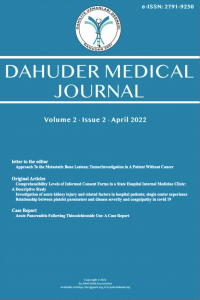Comprehensibility Levels of Informed Consent Forms in a State Hospital Internal Medicine Clinic: A Descriptive Study
Öz
Objectives: Herein, we aimed to determine the comprehensibility levels of written informed consent forms in a state hospital internal medicine clinic.
Methods: Twenty-eight informed consent forms for diagnostic interventions, treatment applications, and hospitalization processes in a state hospital internal medicine clinic were evaluated with the comprehensibility indexes developed by Ateşman and Bezirci-Yılmaz. We evaluated comprehensibility in four main groups: primary (1st-8th grade), high school (9th-12th grade), undergraduate (13th-16th grade), and graduate education (over 16th grade).
Results: According to both comprehensibility indexes, all forms required at least a high school education. According to Ateşman, median comprehensibility was at the 13th-14th grade; according to Bezirci-Yılmaz, a median of 14.6 years of education was required for comprehensibility.
Conclusion: For comprehensibility of the informed consent forms used in the internal medicine clinic, at least high school and median university-level education were required. Considering the rate of population with a high school or higher education degree in Turkey was 43% in 2020, it is predicted that the patients’ comprehensibility of the written informed consent would be seriously low. Immediate regulations are required ethically and legally to increase the comprehensibility of existing written informed consent forms throughout society.
Anahtar Kelimeler
comprehensibility consent forms informed consent internal medicine
Kaynakça
- Ersoy N. Klinik Etiğin Önemli Bir Sorunu: Aydınlatılmış Onam. Turkiye Klinikleri J Med Ethics. 1994;2:131-6.
- World Medical Association. World Medical Association Declaration of Helsinki. Ethical principles for medical research involving human subjects. Bull World Health Organ. 2001;79:373-4.
- Goldbort R. Readable writing by scientists and researchers. J Environ Health. 2001;63:40-1.
- Flesch R. A new readability yardstick. J Appl Psychol. 1948;32:221-33.
- Walsh TM, Volsko TA. Readability assessment of internet-based consumer health information. Respir Care. 2008;53:1310-5.
- Al-Khalifa H, Al-Ajlan A. Automatic readability measurements of the Arabic text: An exploratory study. Arab J Sci Eng. 2010;35:103-124.
- Ateşman E. Measuring readability in Turkish. AU Tömer Lang J. 1997;58:171–4.
- Bezirci B, Yılmaz AE. A software library for measurement of readability of texts and a new readability metric for Turkish. DEÜ FMD. 2010;12:49–62.
- Türkiye İstatistik Kurumu. Bitirilen eğitim düzeyine göre nüfusun dağılımı (25+yaş). http://data.tuik.gov.tr/Kategori/GetKategori?p=egitim-kultur-spor-ve-turizm-105&dil=1. Erişim tarihi 17 Temmuz 2021.
- UNESCO Institute for Statistics. Mean years of schooling-Turkey. http://data.uis.unesco.org/. Erişim tarihi 17 Temmuz 2021.
- Weiss BD. Health literacy and patient safety: help patients understand. 2nd ed. Chicago, Ill: American Medical Association Foundation and American Medical Association; 2007.
- Eltorai AE, Naqvi SS, Ghanian S, Eberson CP, Weiss AP, Born CT, Daniels AH. Readability of Invasive Procedure Consent Forms. Clin Transl Sci. 2015 Dec;8(6):830-3. doi: 10.1111/cts.12364.
- Ebem E , Tutar M , Yıldız M , Canıtez A , Kara Ö , Kozanhan B. İntravenöz ve İntramüsküler Enjeksiyon Bilgilendirilmiş Onam Formlarının Okunabilirlik Açısından Değerlendirilmesi. Anadolu Klin. 2019;24:132-136. doi: 10.21673/anadoluklin.484708
- Ay IE, Doğan M. An Evaluation of the Comprehensibility Levels of Ophthalmology Surgical Consent Forms. Cureus. 2021 Jul 26;13(7):e16639. doi: 10.7759/cureus.16639.
- Boztaş N, Özbilgin Ş, Öçmen E, Altuntaş G, Özkardeşler S, Hancı V, Günerli A. Evaluating the Readibility of Informed Consent Forms Available Before Anaesthesia: A Comparative Study. Turk J Anaesthesiol Reanim. 2014 Jun;42(3):140-4. doi: 10.5152/TJAR.2014.94547
Öz
Kaynakça
- Ersoy N. Klinik Etiğin Önemli Bir Sorunu: Aydınlatılmış Onam. Turkiye Klinikleri J Med Ethics. 1994;2:131-6.
- World Medical Association. World Medical Association Declaration of Helsinki. Ethical principles for medical research involving human subjects. Bull World Health Organ. 2001;79:373-4.
- Goldbort R. Readable writing by scientists and researchers. J Environ Health. 2001;63:40-1.
- Flesch R. A new readability yardstick. J Appl Psychol. 1948;32:221-33.
- Walsh TM, Volsko TA. Readability assessment of internet-based consumer health information. Respir Care. 2008;53:1310-5.
- Al-Khalifa H, Al-Ajlan A. Automatic readability measurements of the Arabic text: An exploratory study. Arab J Sci Eng. 2010;35:103-124.
- Ateşman E. Measuring readability in Turkish. AU Tömer Lang J. 1997;58:171–4.
- Bezirci B, Yılmaz AE. A software library for measurement of readability of texts and a new readability metric for Turkish. DEÜ FMD. 2010;12:49–62.
- Türkiye İstatistik Kurumu. Bitirilen eğitim düzeyine göre nüfusun dağılımı (25+yaş). http://data.tuik.gov.tr/Kategori/GetKategori?p=egitim-kultur-spor-ve-turizm-105&dil=1. Erişim tarihi 17 Temmuz 2021.
- UNESCO Institute for Statistics. Mean years of schooling-Turkey. http://data.uis.unesco.org/. Erişim tarihi 17 Temmuz 2021.
- Weiss BD. Health literacy and patient safety: help patients understand. 2nd ed. Chicago, Ill: American Medical Association Foundation and American Medical Association; 2007.
- Eltorai AE, Naqvi SS, Ghanian S, Eberson CP, Weiss AP, Born CT, Daniels AH. Readability of Invasive Procedure Consent Forms. Clin Transl Sci. 2015 Dec;8(6):830-3. doi: 10.1111/cts.12364.
- Ebem E , Tutar M , Yıldız M , Canıtez A , Kara Ö , Kozanhan B. İntravenöz ve İntramüsküler Enjeksiyon Bilgilendirilmiş Onam Formlarının Okunabilirlik Açısından Değerlendirilmesi. Anadolu Klin. 2019;24:132-136. doi: 10.21673/anadoluklin.484708
- Ay IE, Doğan M. An Evaluation of the Comprehensibility Levels of Ophthalmology Surgical Consent Forms. Cureus. 2021 Jul 26;13(7):e16639. doi: 10.7759/cureus.16639.
- Boztaş N, Özbilgin Ş, Öçmen E, Altuntaş G, Özkardeşler S, Hancı V, Günerli A. Evaluating the Readibility of Informed Consent Forms Available Before Anaesthesia: A Comparative Study. Turk J Anaesthesiol Reanim. 2014 Jun;42(3):140-4. doi: 10.5152/TJAR.2014.94547
Ayrıntılar
| Birincil Dil | İngilizce |
|---|---|
| Konular | İç Hastalıkları |
| Bölüm | Research Articles |
| Yazarlar | |
| Yayımlanma Tarihi | 29 Nisan 2022 |
| Gönderilme Tarihi | 16 Ocak 2022 |
| Yayımlandığı Sayı | Yıl 2022 Cilt: 2 Sayı: 2 |
Cited By
Improving Clinical Communication: a qualitative study on the Informed Consent
Revista de Lingüística y Lenguas Aplicadas
https://doi.org/10.4995/rlyla.2024.19803



